Photo by Taryn Lopez.
Pavlof Volcano degasses in July 2017.
Aleutian volcanoes release unexpected carbon volume
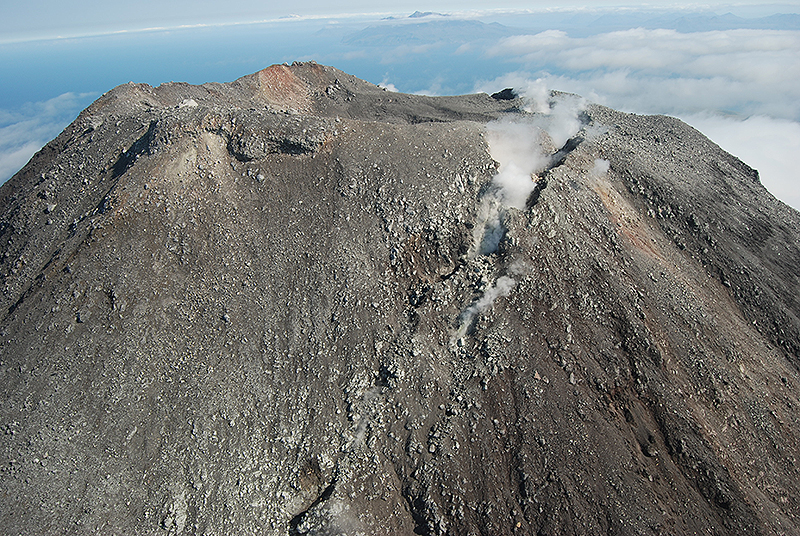
Gas escapes from a fracture in Kanaga Volcano’s summit, as viewed from the west, on Sept. 20, 2015. The volcano lies in the Aleutian Islands on the first island west of Adak.
Carbon carried deep into the Earth where continental plates collide can return to the atmosphere in unexpectedly large amounts via volcanic degassing, a UAF scientist’s study has concluded.
Research associate professor Taryn Lopez and a dozen other scientists looked at what happens along an arc stretching from Cook Inlet westward to the tip of the Aleutian Islands.
Volcanoes along the arc belch carbon from three sources: the sinking oceanic plate or slab, the mantle wedge overlying the descending slab and the overriding crust.
Earlier studies from elsewhere estimated that minimal amounts of organic carbon in ocean floor sediments and inorganic carbon from the subducted slab crust would return to the atmosphere.
But Lopez and her colleagues found that 43% to 61% of sediment-derived organic carbon in the slab returns to the atmosphere through volcanic degassing in the central Aleutians. About 6% to 9% of inorganic carbon from the slab crust returns to the atmosphere by degassing of western Aleutian volcanoes.
The scientists were able to deduce this by analyzing gas from 17 volcanoes for its proportion of carbon 12 and 13 isotopes, a signature that reveals the carbon’s source.
“These results help clarify our understanding of the fate of subducted carbon and can help improve global climate models,” Lopez said.
Photo by Hank Statscewich.
Tyler Hennon, a research assistant professor at the UAF College of Fisheries and Ocean
Sciences, prepares to launch Gretel into Resurrection Bay in spring 2023.
Ocean glider data could help fisheries management
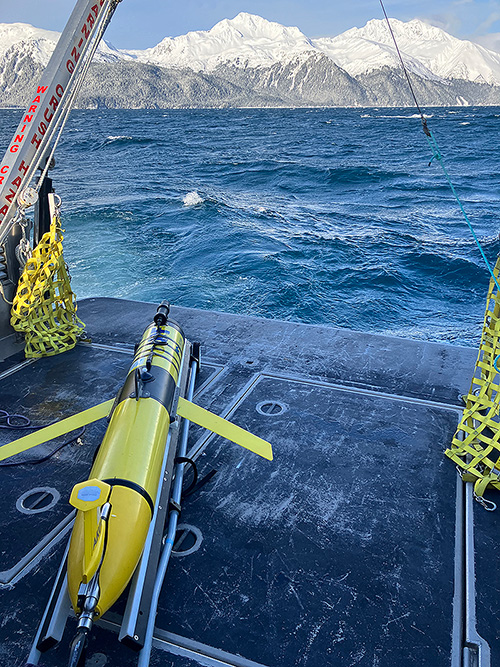
An autonomous underwater vehicle named Shackleton sits on the deck of the UAF research vessel Nanuq before its launch into Resurrection Bay in spring 2023.
Torpedo-like underwater gliders operated by UAF are gathering data in the Gulf of Alaska that could help managers better predict fish populations.
The battery-powered vehicles, dubbed Gretel and Shackleton, collect data that can identify conditions that trigger the spring phytoplankton bloom, an annual explosion of oceanic microscopic life. The bloom creates a feast for the ocean food web.
For the past three years, the gliders have recorded temperature, light, salinity, chlorophyll and fluorescence in the gulf. They’ve even acoustically determined densities of fish and zooplankton.
UAF professor Seth Danielson said both the timing and species composition of the phytoplankton bloom are linked to the health and size of fish populations. That could be of interest to the North Pacific Fishery Management Council.
“We’ll be able to tell the NPFMC if the spring bloom is early or late, or strong or weak,” Danielson said. “As the technology improves we eventually will be able to assess and track measures of food quality for the fishes.”
Satellite facility keeps expanding
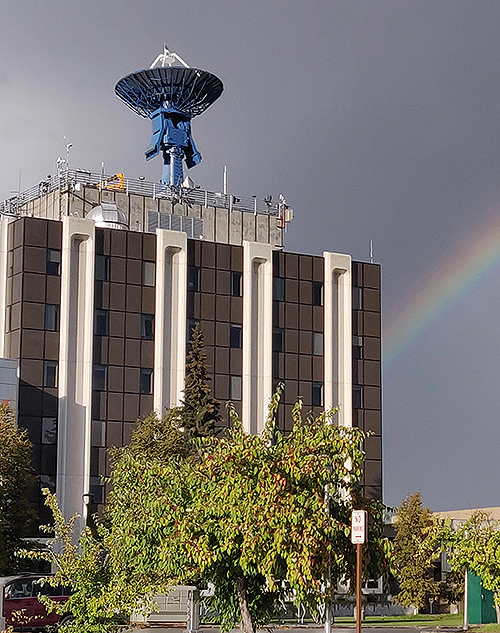
The Elvey Building houses the Alaska Satellite Facility, part of the Geophysical Institute at the University of Alaska Fairbanks.
UAF’s Alaska Satellite Facility began a five-year, $70 million contract July 1, 2023, to continue running a NASA archive center for synthetic aperture radar data.
Synthetic aperture radar sensors on satellites broadcast in radio frequencies and record the energy reflected back from Earth. Because radio waves are longer than visible and infrared light, they aren’t blocked by clouds.
The recorded radar data, after being received by the Alaska Satellite Facility’s dishes, is used to produce imagery that can improve our understanding of the Earth and quicken disaster responses.
The facility, one of 12 in NASA’s Earth observation data system, employs nearly 100 people, almost twice as many as five years ago. The data it handles soon will expand greatly when NASA and the Indian Space Research Organization launch a new Earth-observing satellite in early 2024.
Researcher helps exploration for graphite
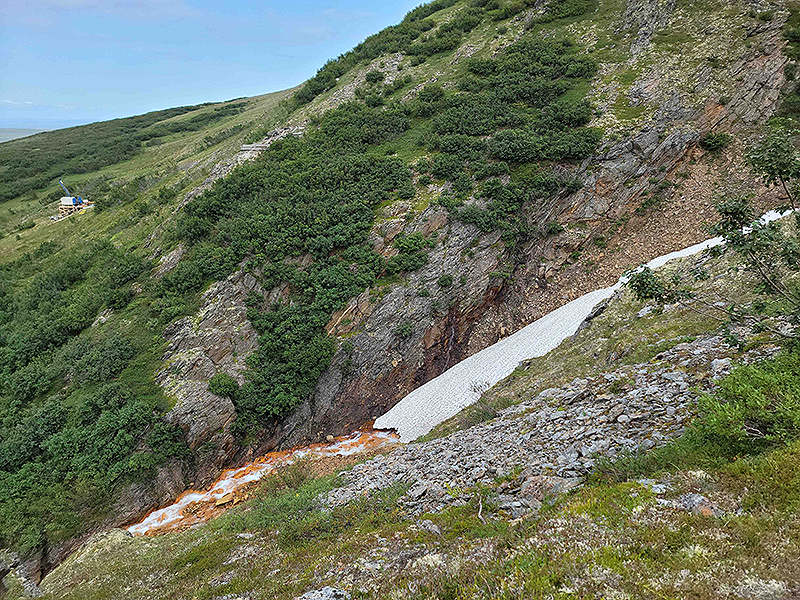
The Graphite Creek deposit’s ore body emerges from the hillside in 2021. At far left is a Graphite One drill rig.
A UAF researcher has helped advance efforts to explore for graphite, an ingredient in the lithium-ion batteries that power modern portable electronics, electric vehicles and renewable energy storage systems.
Sean Regan, an assistant professor of geology, was part of a scientific team that revealed the metamorphic history of a high-grade graphite deposit on the Seward Peninsula. The deposit is among the largest found in the United States, which extracts no graphite of its own.
Geologists have had little understanding of the processes that lead to creation of high-grade flake graphite. That hinders discovery of such deposits.
The study provided a better picture of how the Seward Peninsula deposit was created, Regan said. “Knowing that can help with exploration,” he said.
Photo by Rod Boyce.
ACUASI’s SeaHunter aircraft flies out of Nenana’s municipal airport on May 5, 2022.
Nenana hangar will support drone cargo test flights
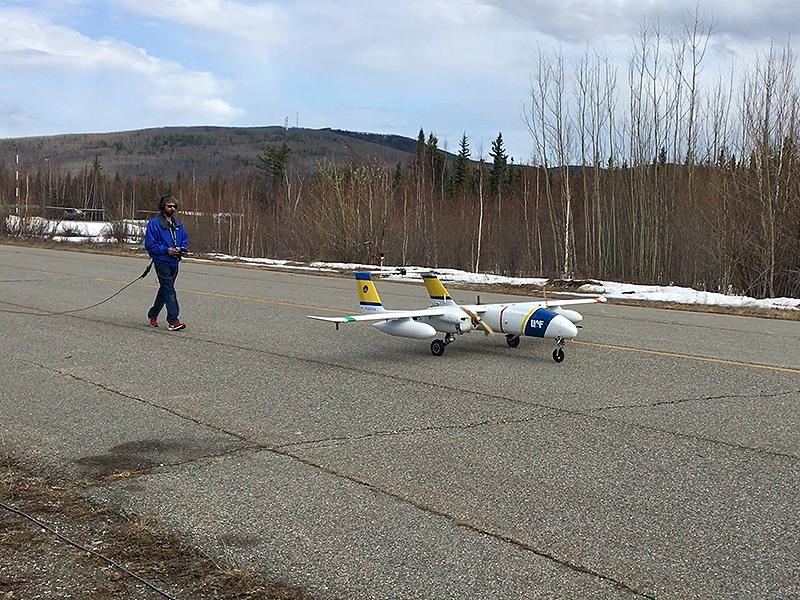
ACUASI pilot Matt Westhoff guides the SeaHunter aircraft to the runway at Nenana’s municipal airport on May 5, 2022, for a test flight.
Nenana’s airport will be the site of a new 4,800-square-foot hangar for UAF’s Alaska Center for Unmanned Aircraft Systems Integration. The hangar will serve as a base for drone cargo test flights between Fairbanks and the small city 54 miles to the southwest.
The University of Alaska Board of Regents approved $3.3 million for the hangar on Feb. 24, 2023.
ACUASI has been using the city-owned Nenana airport regularly for test flights and wants the city to become a part of an Interior drone testing hub. The airport does not have any available hangars.
The new hangar will provide year-round space for drone storage and maintenance and testing of equipment designed to increase communication among all airspace users.
HAARP helps defend against dangerous asteroids
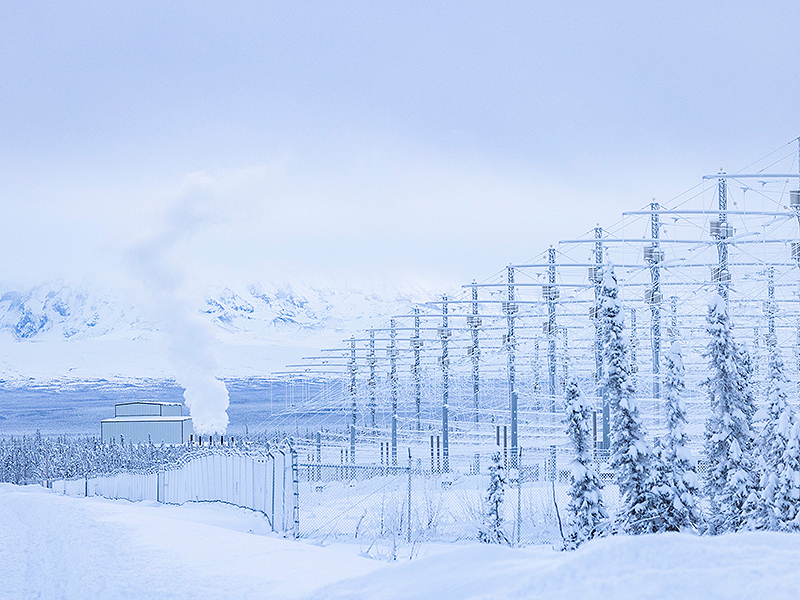
The High-frequency Active Auroral Research Program facility in Gakona is covered in frost on Dec. 20, 2022, as temperatures hit 40 degrees below zero.
A powerful transmitter operated by UAF sent long-wavelength radio signals into space in late December 2022 with the purpose of bouncing them off a passing asteroid to learn about its interior.
The 500-foot asteroid, 2010 XC15, passed by Earth at twice the distance to the moon.
Results of the experiment at UAF’s High-frequency Active Auroral Research Program facility at Gakona could aid efforts to defend Earth from larger, dangerous asteroids.
The U.S. has already been using radar imaging to view asteroids. The radar employs shorter wavelength signals that bounce off the surface but don’t penetrate an object.
Long wavelength radio signals can reveal the interior of objects. Knowing the distribution of mass inside a dangerous asteroid could help scientists create a way to deflect it from Earth.
Small fire has big benefits

Researchers hike through the Yankovich Road Fire site on Aug. 1, 2022.
A small fire on UAF’s North Campus area has big potential for research, training and education purposes.
The Yankovich Road Fire ignited in mid-July 2021 from an undetermined cause, as yet. Helicopters and airplanes dropped water, while smokejumpers and ground crews attacked the blaze. They contained the fire to 3.6 acres, stopping it about 330 feet from the closest home.
Since then, researchers have installed monitoring transects to track how the forest responds. They’re also working on installation of interpretive signs to raise public awareness of wildfires.
“People know where it is, you can park there, you don’t need a permit,” said Alison York, coordinator for the UAF Alaska Fire Science Consortium. “It just hit all of us at the same time: This could be a really nice self-guided tour opportunity.”
The site is a 10-minute walk from a public parking lot at the UAF Large Animal Research Station. The interpretive signs on the route will describe wildland fire management, ecological succession, the role of wildland fires in the ecosystem, the impacts of climate change to the boreal forest and some ways to protect homes from wildfire.
Photo by Seth Beaudreault, Toolik Field Station.
Muskoxen near Toolik Field Station browse shrub branches exposed above the snow’s
surface on a warm day in April 2020.
Northern shrubs: frigid but not rigid
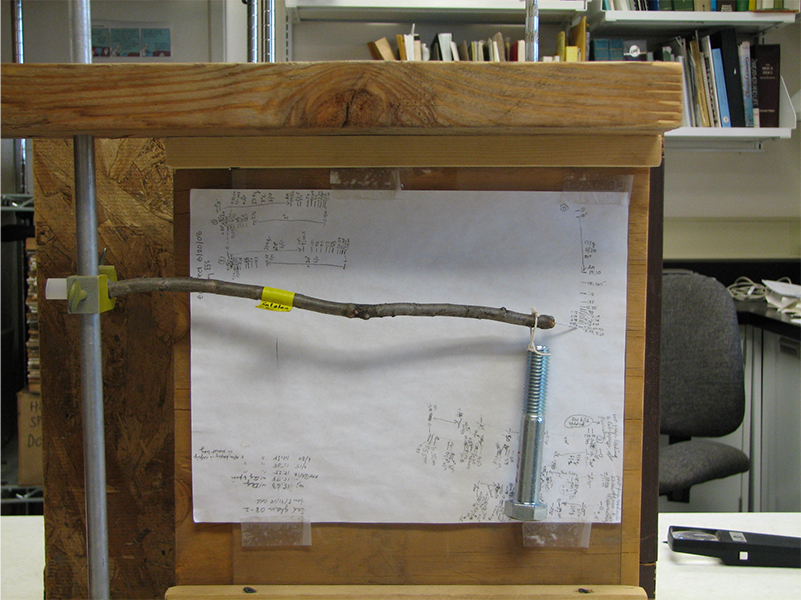
Researchers Syndonia Bret-Harte and Peter Ray designed and built the apparatus pictured above in 2006 to simulate the bending of branches under a heavy snowpack at UAF’s Toolik Field Station. A branch is held in place on one end and a weight is placed on the free end. A needle attached to the free end tracks the movement of the branch as it bends under the weight and rises again once the weight is unloaded.
An accidental experiment has revealed that woody northern plants actually get more bendable when frozen.
Syndonia Bret-Harte, a professor with the UAF Institute of Arctic Biology, and Peter Ray, a professor emeritus at Stanford University, discovered the counterintuitive phenomenon. They called it cryocampsis, from the Greek roots “cryo” for “frozen” and “campsis” for “bending.”
“We were doing some springtime experiments on the deck outside of a lab at Toolik Field Station,” Bret-Harte said, “and we just happened to have a cold night that went below freezing. Peter came back the next morning and said, ‘Hey, that’s weird. What’s going on here?’”
Common sense would say that freezing temperatures make branches more rigid. But the branches had bent even farther in the cold.
Over 15 years, Bret-Harte and Ray tested nearly 200 species using a cantilever apparatus that Ray built. All Arctic and most boreal plants displayed cryocampsis. Very few temperate and Mediterranean species and no tropical species did.
Bret-Harte said cryocampsis likely confers an evolutionary advantage. “If you’re down below the snow surface in the winter, you’re not exposed to the abrasive snow crystals blown by the wind above the snow surface. You’re not exposed to herbivores,” she said.
Bret-Harte warned that if cryocampsis happens less often as the Arctic warms, it could reinforce climate change as more dark, sunlight-heated branches poke above the snow.
Adopt a mammoth for science
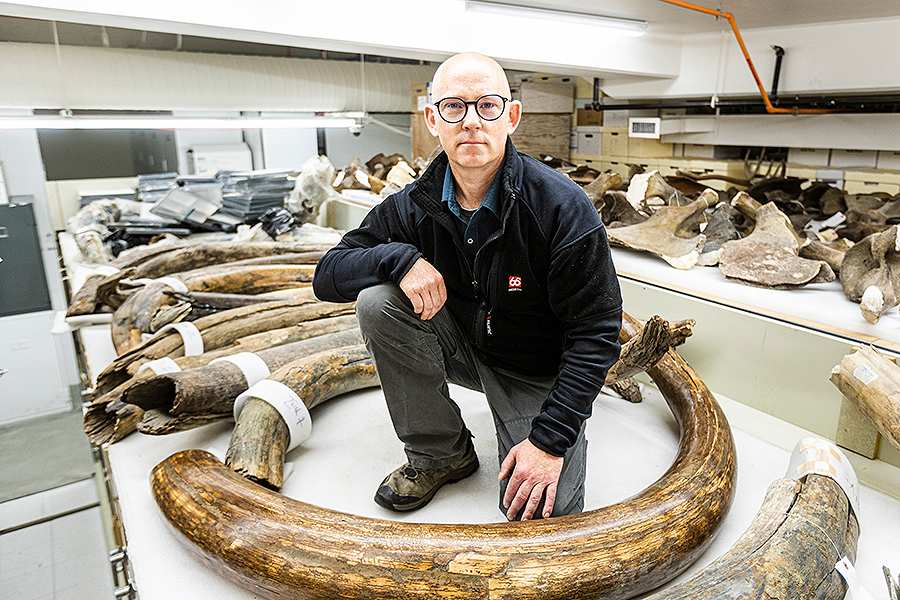
Matthew Wooller kneels among the mammoth tusk collection at the University of Alaska Museum of the North in 2021. Wooller is leading the museum’s Adopt a Mammoth program, which dates and identifies specimens at the museum.
The public is helping to search for the “youngest” mammoth specimen in the University of Alaska Museum of the North’s collection.
The Adopt a Mammoth program encourages sponsorship of each of the roughly 1,500 teeth, tusks and bones in the collection. A $350 donation pays for radiocarbon testing to date the fossil.
The “youngest” dated mammoth in mainland Alaska so far is about 11,600 years old, but the massive animals may have survived much longer. A remnant population on neighboring St. Paul Island survived until about 5,600 years ago.
Finding a specimen from 10,000 years ago or less would extend the mainland extinction date to a period well after the earliest people arrived in Interior Alaska.
“It’s a fun philanthropic project, but it’s also rooted in solid science,” said Matthew Wooller, the director of UAF’s Alaska Stable Isotope Facility and the leader of the Adopt a Mammoth project. “If we find a young mammoth fossil on the mainland, that’s big news.”


